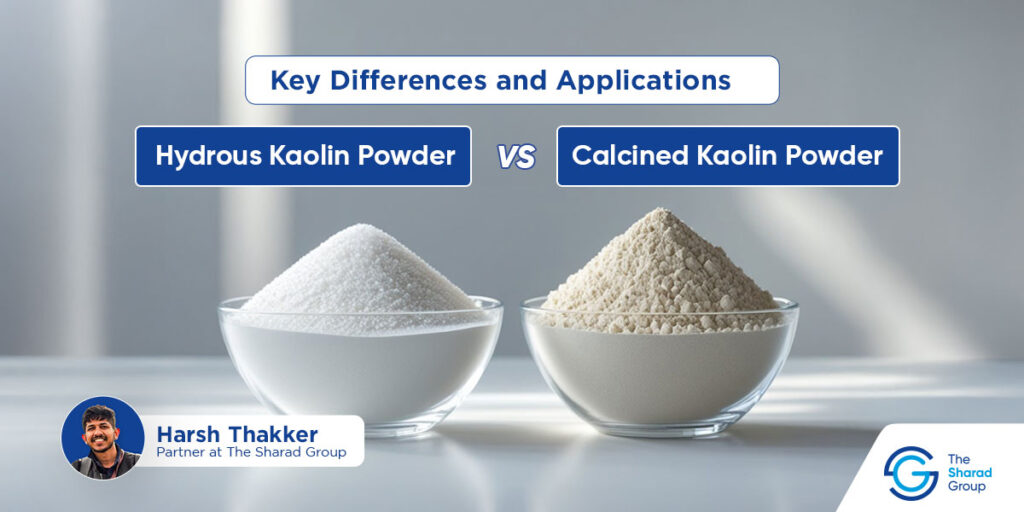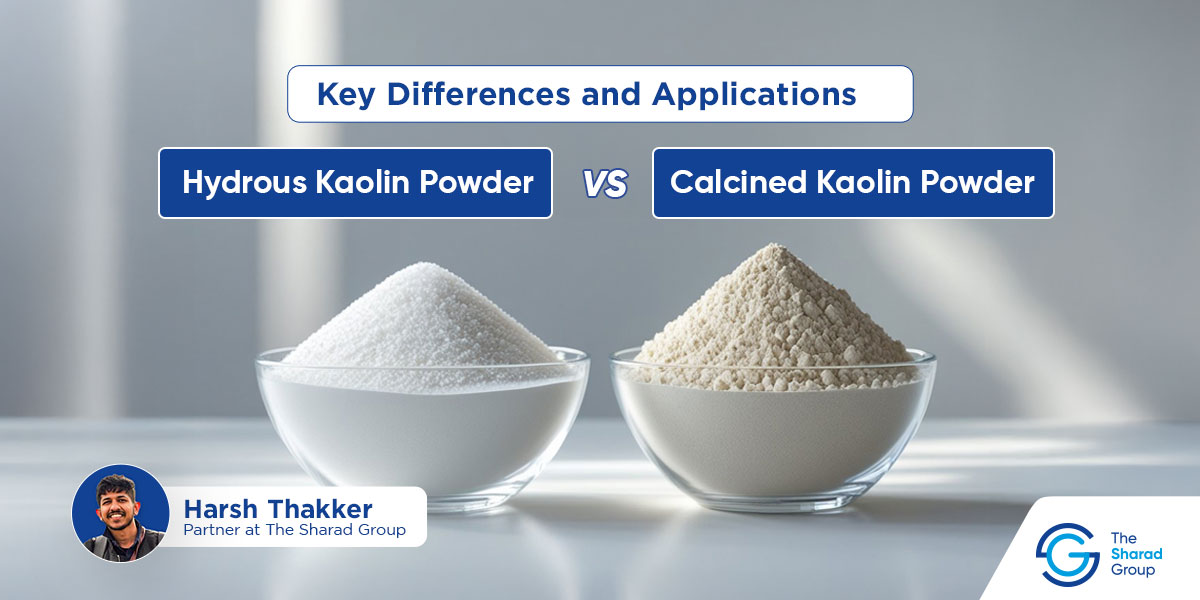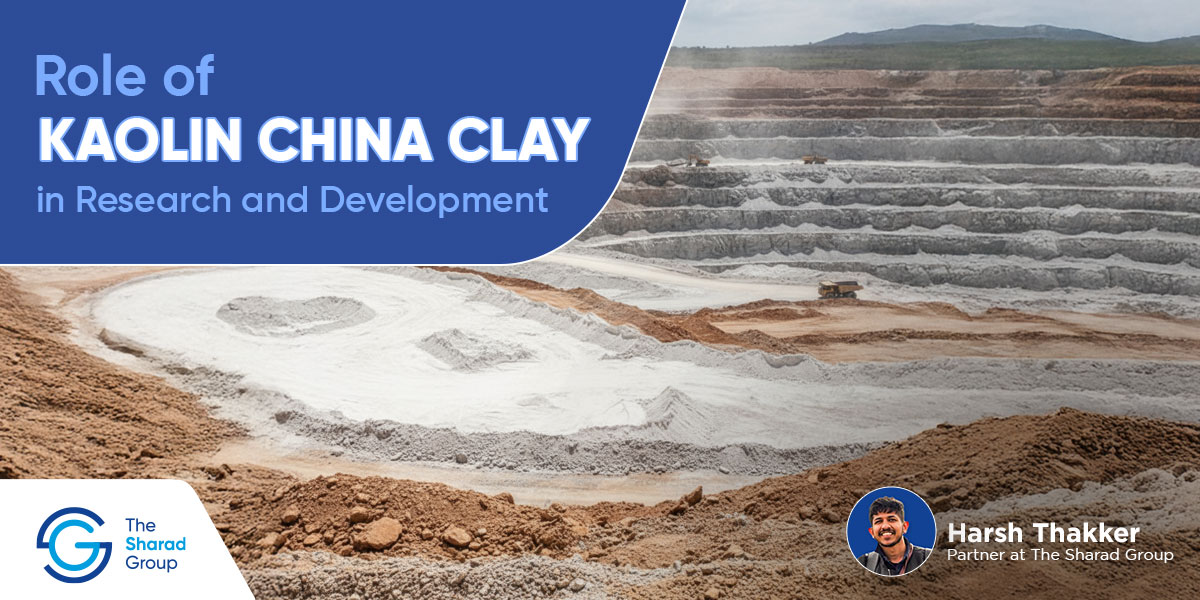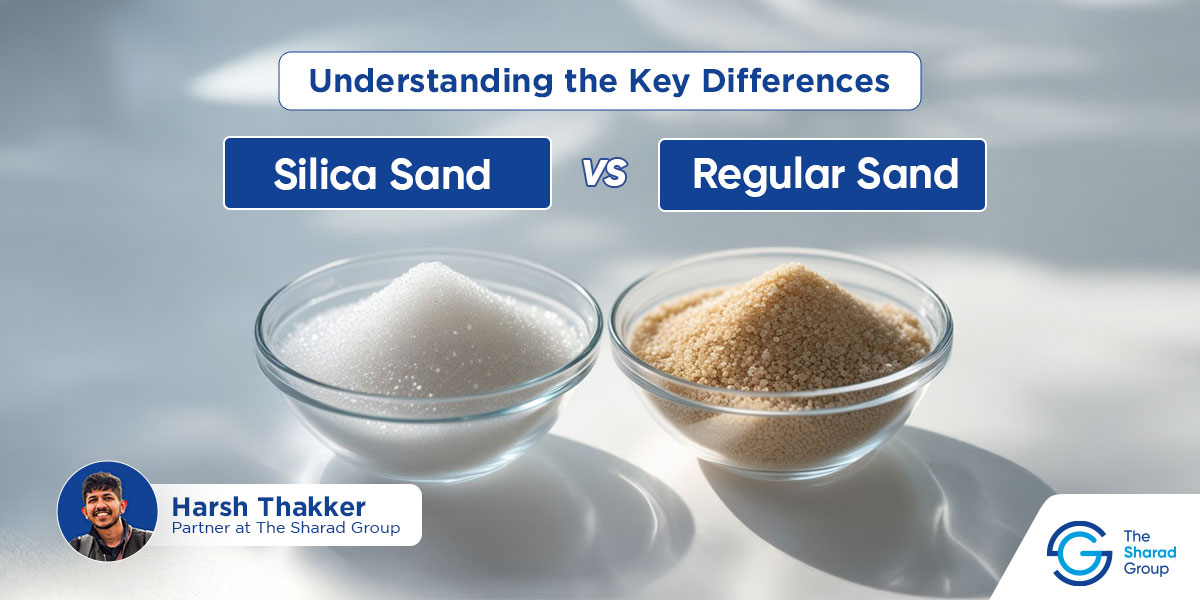As of 2025, the global Kaolin market is worth more than $4.2 billion.
But that doesn’t refer to just a single raw material – the global kaolin market is divided between different forms of kaolin, the basic raw material.
In this post, we’ll talk about two of the most widely used forms of kaolin: hydrous kaolin powder and calcined kaolin.
While both of them come from the same original kaolin deposit, they have different processing methods, properties, and applications.
So, if you’re confused about which one to use for your products, this is the only guide you’ll need to read.
I’ve used my 15+ years of experience to compile this complete guide on the differences between hydrous kaolin and calcined kaolin powder. I’ve covered everything from their processing methods to chemical characteristics to industry-wise use cases in this blog.
Dive in to find out which kaolin powder is right for you!
Hydrous Kaolin Powder vs. Calcined Kaolin: Table of Contents
- TL;DR: Hydrous Kaolin Powder vs Calcined Kaolin – Table of Differences
- What is Hydrous Kaolin Powder?
- What is Calcined Kaolin?
- Hydrous Kaolin Powder vs Calcined Kaolin: Industrial Applications
- How to Choose Between Hydrous Kaolin Powder vs Calcined Kaolin
- The Sharad Group: Your Reliable Kaolin Manufacturer
- Hydrous Kaolin Powder vs Calcined Kaolin: FAQs
TL;DR: Basic Differences Between Hydrous Kaolin Powder vs Calcined Kaolin
Just need to know the basic differences between hydrous and calcined kaolin powders?
Here’s a table capturing the key differences between the two materials:
| Feature | Hydrous Kaolin | Calcined Kaolin |
| Example | Think of it as the “flour” you get from mining a kaolin deposit. | Think of it as the “toast” you get by heating the mined kaolin powder. |
| Processing | Mined, purified with water, and dried. No heat treatment. | Hydrous kaolin is baked in a kiln at very high temperatures (~1000°C+). |
| Key Difference | It still contains its natural water (chemically bound). | The heat process removes all the water, changing its very structure. |
| Main Quality | It’s soft and plastic (moldable). | It’s hard, abrasive, and absorbent. |
| Common Uses | Premium paper coatings, paints (to flatten sheen), rubber to reinforce tires, and plastics. | Premium paper coatings, paints (to flatten sheen), rubber to reinforce tires, plastics. |
What's on this page:
ToggleWhat is Hydrous Kaolin Powder?
Hydrous Kaolin Powder is the raw form of Kaolin with minimal processing.
When you mine a naturally occurring kaolin deposit, what you get is a powdery form of the material – hydrous kaolin powder.
It is then processed through water-washing and purification methods to remove undesirable materials, to give us hydrous kaolin powder ready for industrial applications.
The chemical formula of hydrous kaolin powder is Al₂Si₂O₅(OH)₄. It thus contains aluminium, silicon, hydrogen and oxygen in different proportions.
Also Read: How Hydrous Kaolin is used in the Fertilizer Industry?
Key Properties of Hydrous Kaolin Powder
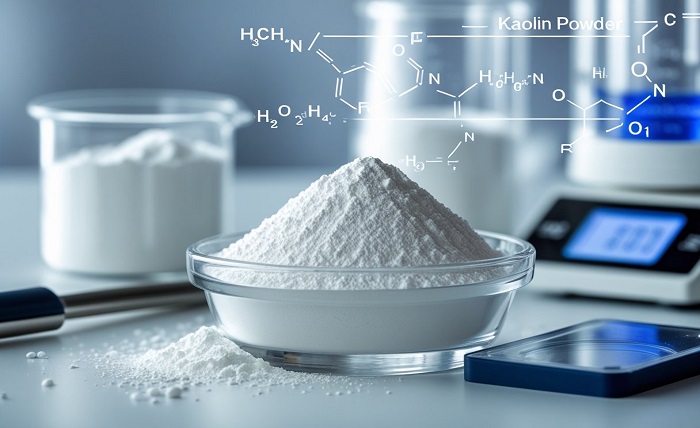
Let’s quickly take a look at the most important properties of hydrous kaolin powder:
- Physical Characteristics: Fine particle size (0.1µm to 4µm) and plate-like structure, which make it an ideal material for strengthening materials like rubber.
- Brightness: Moderate brightness (85-90 GE), which is why hydrous kaolin powder is used as an additive in paint and paper manufacturing.
- Moisture Content: Contains approximately 14% bound water of hydration. This is one reason it’s used in pesticide formulation.
- Plasticity: Comes with high plasticity, which makes it excellent for molding. It is thus directly added to plastics as a functional filler.
- Chemical Inertness: Chemically inert, making it ideal for applications in the pharmaceutical industry.
Next, let’s briefly take a look at the definition and characteristics of calcined kaolin.
What is Calcined Kaolin?
Calcined Kaolin is a form of kaolin that is heated to remove its inherent moisture content.
Simply put, calcined kaolin is hydrous kaolin powder that has undergone the process of calcination: the hydrous kaolin powder is heated to 1000°C+ temperatures in special kilns.
The chemical formula of calcined kaolin is Al₂O₃·2SiO₂, which means it doesn’t contain any water, which is dried off through the heating processes.
Let me quickly show you how this happens.
Calcined Clay – Brief Overview of the Calcination Process
- First, raw kaolin, which contains about 14% chemically bound water, is heated to around 550°C-800°C to knock out the moisture content.
- What you get is metakaolin – a dehydroxilized material that is also highly reactive to other compounds.
- Next, metakaolin (i.e. Kaolin whose crystalline structure has been destroyed by heating) is heated to temperatures of 1000°C-1050°C.
- During this process, the kaolin’s structure starts re-crystalising – it loses its reactivity and becomes a strong and stable material.
- The resultant material is calcined kaolin – a hard, abrasive material that is resistant to electricity, heat, and pressure.
Here’s a table recapping the entire kaolin processing technique:
| Stage | Temperature Range | Key Change | Primary Property |
| Hydrous Kaolin | Ambient | None, found in the natural stage. | Soft, Platy, Contains Water |
| Metakaolin | 550°C – 800°C | Dehydroxylation (Loss of water, becomes amorphous). | Chemically Reactive |
| Calcined Kaolin | 1000°C – 1050°C+ | Recrystallization (Forms mullite). | Hard, Abrasive, Opaque |
Metakaolin – the result of the first step in the process of creating calcined kaolin – is widely used as a pozzolan. It is used in high-performance concrete to give it structural strength and durability.
On the other hand, calcined kaolin has a wide range of industrial applications due to its chemical properties. I’ve broken them down below:
Key Properties of Calcined Kaolin Powder
- Physical Characteristics: Amorphous, porous structure with internal air voids, which is why it’s often used as an insulator in plastic cable covering.
- Brightness: Enhanced brightness (85-95 GE), making it one of the best raw materials for premium paper coatings and paint manufacturing.
- Mohs Hardness: Higher hardness (3 vs. 2 for hydrous). This is why it’s widely used to create ceramics – it offers mechanical strength and reduces shrinkage.
- Oil Absorption: Higher oil absorption (50-95g/100g), which is why it’s used to create hydrophobic sponges for cleaning oil spills.
- Thermal Properties: Improved thermal stability and electrical insulation, making it a widely used material in manufacturing plastics.
As you can see, calcined kaolin can have several useful applications across a wide range of industries.
But should you choose it over hydrous kaolin powder?
Let me help you make the decision through my detailed breakdown between the two forms of kaolin.
Hydrous Kaolin Powder vs Calcined Kaolin: Table of Differences
First, let’s take a look at the key differences between the chemical and physical properties of hydrous kaolin powder and calcined kaolin powder:
| Property | Hydrous Kaolin | Calcined Kaolin |
| Processing | Water-washed, purified | High-temperature calcination |
| Chemical Structure | Hydrated aluminosilicate | Anhydrous aluminosilicate |
| Water Content | ~14% bound water | 0% (fully dehydrated) |
| Crystalline Structure | Crystalline | Amorphous |
| Brightness (GE) | 85-90 | 85-95 |
| Porosity | Low | High (internal air voids) |
| Hardness (Mohs) | 2 | 3 |
| Plasticity | High | Low |
| Oil Absorption | 30-50 g/100g | 50-95 g/100g |
| Refractive Index | 1.56 | 1.62 |
| Cost Factor | Lower production cost | ~3x more expensive than hydrous |
| LOI (Loss on Ignition) | ~13% | ~0% |
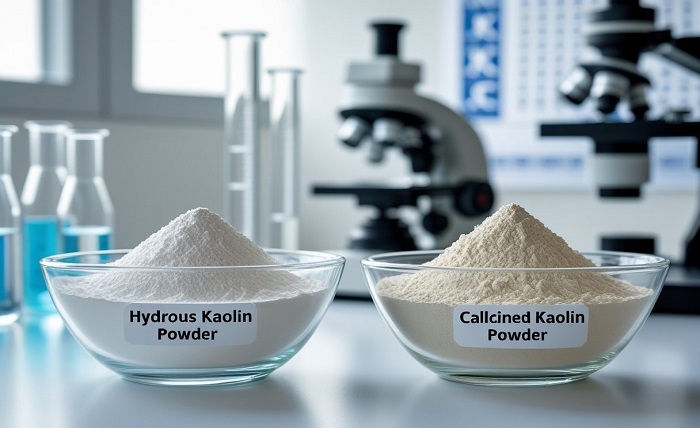
Hydrous Kaolin Powder vs Calcined Kaolin: Industrial Applications
Now that we’ve explored the differences between their properties, let’s find out how and why they are used in different industries:
| Industry | Hydrous Kaolin Applications | Calcined Kaolin Applications |
| Paper | Filler and coating for brightness and smoothness | Premium paper coatings for enhanced brightness |
| Ceramics | Essential for plasticity in clay bodies | Provides mechanical strength, reduces shrinkage |
| Paints & Coatings | Extender pigment in gloss/semi-gloss paints | Opacity enhancement in matt paints, gloss reduction |
| Rubber | Adds strength and improves processing | Reinforcing filler, improves tensile strength |
| Plastics | Functional filler | Enhances mechanical/thermal properties |
| Cosmetics | Gentle, inert base for creams and powders | Not typically used |
| Pharmaceuticals | Used in tablets and medicinal formulations | Not typically used |
| Agriculture | Pesticide formulations | Physical pesticide, sunscreen for fruit |
| Construction | Not typically used | Pozzolan in concrete (metakaolin) |
| Electrical | Not typically used | Insulator in plastic cable covering |
How to Choose Between Hydrous Kaolin Powder vs Calcined Kaolin
As you can see, both hydrous and calcined kaolin have some overlapping applications. Both can be used in paper, paint, plastic, ceramic and rubber manufacturing.
So, if you’re not sure which material is right for you, don’t worry – I’m going to walk you through some factors that you can consider to choose the ideal kaolin material:
How to Decide Between Hydrous and Calcined Kaolin Powder?
Here are the four key factors you should consider to decide which material is right for you:
Performance Requirements
If you need a form of kaolin that can offer high brightness for ceramics, paints or paper coatings, go for calcined kaolin.
On the other hand, if plasticity is your priority, I suggest using hydrous kaolin – it will help you mould ceramics and act as a filler for flexible plastics.
Budget Constraints
If you’re working with a tight budget but need a high-performance material, hydrous kaolin will get the job done.
However, if you need a premium raw material, calcined clay will definitely offer a better finish, strength, and shine to your products.
Technical Specifications
While the size of both hydrous and calcined kaolin particles is roughly the same, the process of calcination creates holes and voids in calcined clay particles.
This makes calcined kaolin porous, and while this porosity might not absorb water, it will absorb other materials like oil.
The particle size of hydrous kaolin, on the other hand, is determined by the nature of the kaolin deposit and refining process. So, you can even request china clay suppliers to create hydrous kaolin with specific particle sizes!
Since its particles can take different sizes, hydrous kaolin can be a very useful filler material for rubber, plastic, and paper production.
Industry-Specific Recommendations
Here, I’ve briefly recapped which material you should choose from based on the properties of calcined and hydrous kaolin powders:
- Paper Industry: For standard manufacturing standard paper, go with hydrous kaolin; calcined kaolin powder is best suited to premium paper grades.
- Ceramics: Go for hydrous kaolin if you want plasticity in your mould; use calcined kaolin for strength or if you want to reduce shrinkage.
- Paints: Hydrous kaolin will help you get perfect gloss finishes; calcined kaolin is ideal for achieving matt and eggshell finishes.
- Rubber/Plastics: Hydrous kaolin is one of the most affordable and durable materials for basic filling; calcined kaolin is ideal as a reinforcing material.
The Sharad Group: Your Reliable China Clay Manufacturers in India
Through this blog, I’ve walked you through a wide range of differences between hydrous and calcined kaolin powders.
To recap, hydrous kaolin is the one that contains water and is in a relatively raw form compared to calcined clay. Its porosity, plasticity, and affordability make it an ideal material for paper, ceramic, pesticide, pharmaceutical, and rubber manufacturing.
Calcined clay is a dehydrated form of kaolin that you get by heating hydrous kaolin powder to around 1,000°C. Its strength, brightness, and lack of water make it a great material for premium paint, high-quality paper, water-resistant plastic, and ceramic manufacturing.
Now, all you need is a good kaolin clay supplier who can deliver large quantities of your preferred material consistently and on time.
That’s where we come in!
As one of the leading china clay manufacturers in India, we at The Sharad Group have 60+ years of experience delivering high-quality kaolin to clients across the country and around the world.
We are conveniently located near one of the most accessible kaolin supply chains in the world – with a manufacturing facility in the globally connected state of Gujarat.
So, reach out to us with your kaolin requirements, get a free sample to find out if it’s right for your operations, and start enhancing your products with a reliable supply of the right kaolin clay materials.
Hydrous Kaolin Powder vs Calcined Kaolin: FAQs
1. As a buyer, what is the main practical difference I should know between hydrous and calcined kaolin powder?
The simplest way to think about it is that hydrous kaolin powder is soft, pliable, and acts as a cost-effective filler and plasticizer. In contrast, calcined kaolin is hard, abrasive, and highly absorbent, making it a premium choice for reinforcement, enhancing opacity, and improving brightness. The choice depends entirely on whether your application requires plasticity or strength and opacity.
2. Why is calcined kaolin more expensive than hydrous kaolin?
Calcined kaolin is approximately three times more expensive because it undergoes an energy-intensive, high-temperature heating process (calcination) that permanently alters its chemical structure. This additional processing step removes bound water, increases brightness, and creates a harder, more porous product, which justifies the higher cost for performance-critical applications.
3. Can both types of kaolin be sourced from the same china clay suppliers?
Yes, absolutely. Reputable china clay manufacturers in India, like The Sharad Group, typically mine the same raw hydrous kaolin deposit. A portion is processed and sold as hydrous kaolin powder, while another portion is sent through the calcination kilns to produce calcined kaolin powder. This allows a single supplier to offer a complete portfolio to meet diverse industrial needs.
4. Which type of kaolin is better for the paper industry: hydrous or calcined?
Both are used, but for different purposes. Hydrous kaolin is an excellent and economical filler for standard paper grades, providing smoothness and moderate brightness. For high-quality, premium papers requiring superior brightness, opacity, and gloss, calcined kaolin powder is the preferred choice for coating applications. Leading china clay suppliers like The Sharad Group often provide blends of both to achieve specific paper qualities.
5. Is calcined kaolin suitable for use in cosmetics and pharmaceuticals?
No, calcined kaolin is not typically used in cosmetics and pharmaceutical products. These industries almost exclusively use hydrous kaolin powder because it is gentle, chemically inert, and retains its natural plate-like structure. This makes it ideal as a base for creams, powders, and medicinal tablets. The hard, abrasive nature of calcined kaolin makes it unsuitable for direct application on skin or in ingestible products.

